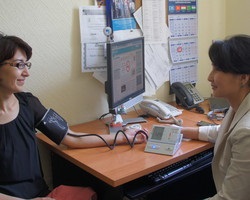Championing the fight against pneumonia
Pneumonia is the single biggest infectious killer of adults and children – claiming the lives of 2.5 million, including 672,000 children, in 2019.
Deaths from COVID-19 will add two million more in 2020, bringing the total to more than four million. No other infection causes anywhere near this burden of death.
This year, World Pneumonia Day, on 12 November 2021, is held during COP 26 – the UN Climate Change Conference.
This is a critical moment to bring together the health, air quality and climate community to tackle the biggest infectious killer on the planet.
Air pollution is the leading risk factor for death from pneumonia across all age groups. Almost a third of all pneumonia deaths were attributable to polluted air, killing around 749,200 in 2019. Household air pollution contributed to 423,000 of these deaths while outdoor air pollution contributed to 326,000.
It is the very young and the very old who are at greatest risk. Children are more susceptible to household air pollution in homes that regularly use polluting fuels and technologies for cooking, heating and lighting. While outdoor air pollution, especially from pollutants emitted by industries and car exhaust smoke, disproportionately affects respiratory health among older adults.
Ninety percent of air pollution-related deaths are concentrated in 40 low- and middle-income countries. In many African countries, air pollution contributes to more than 50 percent of all pneumonia deaths. And while pneumonia deaths from household air pollution are declining in Africa, they are tragically increasing as a result of outdoor air pollution. This is also true for Asia.
The need for clean air action is clear. Reducing air pollution will deliver significant benefits to health and the environment.
This World Pneumonia Day, Every Breath Counts is calling on governments with heavy burdens of pneumonia and air pollution to commit to reducing air pollution-related pneumonia deaths by 50 percent by 2030.
- Raise awareness about pneumonia, the world’s leading killer of children under the age of five;
- Promote interventions to protect against, prevent and treat pneumonia; and
- Generate action to combat pneumonia.
Key facts:
- Pneumonia is the leading infectious killer of children under five years of age worldwide.
- Pneumonia killed 920136 children under the age of 5 in 2015, accounting for 16% of all deaths of children under five years old.
- Pneumonia is an easily preventable and treatable cause of death in children and yet a child dies from the infection every 20 seconds.
- Children can be protected from pneumonia; it can be prevented with simple interventions and treated with low-cost, low-tech medication and care.
What is Pneumonia?
Pneumonia is an acute respiratory infection affecting lungs. Normally the alveoli (small sacs in lungs) are filled with air during breathing, however in pneumonia the alveoli are filled with pus and fluid which makes breathing painful and reduces oxygen intake. Pneumonia is caused by a number of infectious agents, including viruses, bacteria and fungi.
Presenting features of pneumonia in children under 5 years of age:
- Cough and/or difficult breathing, with or without fever,
- Fast breathing or lower chest wall indrawing (chest moves in or retracts during inhalation; while in a healthy person, the chest expands during inhalation).
- Very severely ill infants may be unable to feed or drink and may also experience unconsciousness, hypothermia and convulsions.
Risk factors:
- A child with a weak immune system such as undernourished or pre-existing illnesses (HIV, measles)
- Environmental factors:
- indoor air pollution(houses using wood or dung as a fuel))
- living in crowded homes
- exposure to second hand smoke by parental smoking
How is pneumonia transmitted?
Pneumonia can be transmitted in a number of ways-
- The viruses and bacteria that are commonly found in a child’s nose or throat can infect the lungs if they are inhaled.
- Organism may also spread via air-borne droplets from a cough or sneeze.
- Pneumonia may spread through blood, especially during and shortly after birth.
Global Action Plan for Prevention and Control of Pneumonia and Diarrhoea:
The Integrated Global Action Plan for the Prevention and Control of Pneumonia and Diarrhoea (GAPPD), by WHO and UNICEF aims to accelerate pneumonia control with a combination of interventions to protect, prevent, and treat pneumonia in children. The goal is to reduce the deaths from pneumonia to fewer than 3 children in 1000 live births, and from diarrhoea to less than 1 in 1000 by 2025.
Ministry of Health and Family Welfare, Government of India is functioning with other ministries through various national prorgrammes (such as MAA, UIP, ICDS) with the involvement of ASHA/ANM/anganwadi worker at community level to protect, prevent and treat pneumonia. Various activities to control pneumonia under child health programme* include:
(a)Protect children from pneumonia by promoting good health practices from birth by:
- Exclusive breastfeeding for 6 months
- Adequate complementary feeding
- Vitamin A supplementation
(b)Prevent children becoming ill from pneumonia and diarrhea by:
- Providing vaccination against diseases such as pertussis (whooping cough), measles, haemophilus influenza type B infections (Hib), pneumococcal (PCV) and rotavirus infections (Universal Immunisation Programme))
- Encouraging handwashing with soap and water
- Provision of safe drinking-water and sanitation
- Reduction in household air pollution (use of safe fuel for cooking in the household)
- HIV prevention and antibiotic prophylaxis for HIV-infected and exposed children
(c)Treat children with appropriate treatment with timely access to trained health care providers either from a community-based health worker, or in a health facility if the disease is severe and can get the antibiotics and oxygen they need to get well.
There are three essential steps to reduce deaths among children under five with pneumonia:
1. Recognize a child is sick: Caregivers may play an important role in recognizing pneumonia’s symptoms and for that all caregivers should know danger signs of pneumonia in children: cough and fast or difficult breathing.
2. Seek appropriate care: The second step is for caregivers to seek appropriate medical care for a child with suspected pneumonia. (Appropriate care includes providers that can correctly diagnose and treat pneumonia, such as hospitals, health centres, dispensaries, community health workers, maternal and child health clinics, outreach clinics).
3. Treat appropriately with antibiotics: Health personnel, including community health worker should treat children with pneumonia with appropriate antibiotics and refer severe cases to health facilities. Inappropriate antibiotic use will waste resources and it will also increase antibiotic resistance.
“Stopping pneumonia isn’t about luck. It’s about action.”












